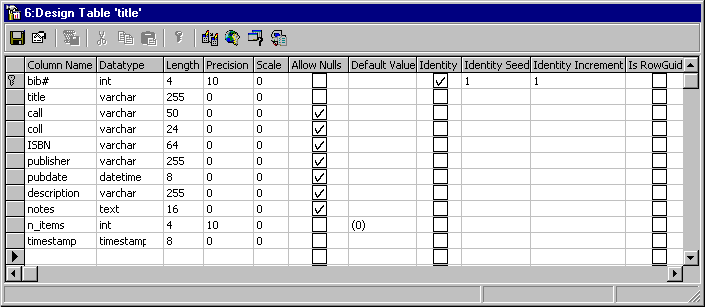Title Table
The title table holds the library title information. The borrower requests a library item by title, but is issued an item. The title table diagram shows the column properties of the table.

- The bib# column is the primary key for a title. The Identity attribute guarantees that a unique number will be generated for each new title added to the table. The identity seed and identity increment are 1. The first bib# to be assigned is 1, and each subsequently added bib# will be incremented by 1.
- The title column holds the title of a library item. This column is registered for full-text search. CML and Full-Text Search describes full-text search in detail.
- The call column is the call number of the title.
- The coll column is the collection of the title. The CML application uses seven collections. Collections are also referred to as media types.
- The ISBN column is the ISBN of a book title or the ISSN for a periodical. This column is registered for full-text search. CML and Full-Text Search describes full-text search in detail.
- The publisher column is the publisher of the title.
- The pubdate column is the date the title was published.
- The description column is a description of the title.
- The notes column contains notes on the title. This is a text data type. The content of the text is actually stored elsewhere; this table maintains the pointer to the location. This column is registered for full-text search. CML and Full-Text Search describes full-text search in detail.
- The n_items column is the number of items assigned to the title. It is a calculated field that's kept up-to-date with triggers on the item table. Insertions and deletions in the item table modify the n_items field appropriately. This an example of adapting the database structure to suit the CML application. The n_items column facilitates the link from the Library Catalog page to AddItems.asp. The value of this number could easily be derived, but precalculating commonly requested aggregates often makes sense, especially when triggers can maintain the data for you.
- The timestamp column holds a database-wide unique number. The value in the timestamp column is updated every time a row containing a timestamp column is inserted or updated. A table can have only one timestamp column. The timestamp provides a way to incrementally rebuild the full-text index on the table. All the CML database tables registered for full-text search (author, subject, and title) have a timestamp column. Null values are not allowed. Storage size is 8 bytes.

